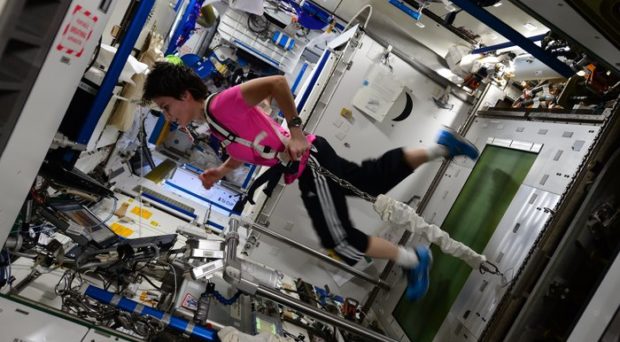
Despite working in the field of space physiology and analogues for over 25 years, I know there’s still so much more we need to know about the effects of microgravity on the human body. Not only that, it will be increasingly important to understand how we can limit negative consequences that come with spending long periods of time in space.
Physiological effects associated with varying periods of microgravity exposure
In the early days of manned space flight, missions were often short. The main body systems affected by acute exposures to microgravity are cardiovascular and neurovestibular, however, they do quickly adapt to the space environment.
In microgravity, the cardiovascular system redistributes blood and fluids from lower to upper body regions giving the individual a ‘puffy face’ and ‘bird-leg syndrome’. In addition, plasma volume is decreased as is the size of the heart. Astronauts often develop a condition known as ‘space anemia’ where they have fewer red blood cells due to a decrease in levels of erythropoietin; this overall cardiovascular deconditioning leads to decreased aerobic capacity.
The vestibular system of astronauts is also affected from the moment they begin to experience microgravity. ‘Space motion sickness’ affects up to 70% of astronauts, however, symptoms such as nausea, fatigue and vomiting subside once adaptation occurs.
One of the most important in-flight countermeasures is undoubtedly exercise.
Nowadays, the average stay length on the International Space Station (ISS) lasts six months. In march 2016, US astronaut Scott Kelly and Russian cosmonaut Mikhail Korniyenko broke the current record by staying 342 days on the ISS.
Longer periods of time spent in microgravity do noticeably affect various body systems. Bones are no longer required to support the weight of bodies as they do on earth and as a result, they begin to lose mass. This effect is seen mostly in the lower limbs where up to 2% of mass a month can be lost in the calcaneus.
The immune system also takes a hit with activity becoming more reduced. In addition, skeletal muscles can suffer from atrophy since they’re no longer used to counteract the effects of gravity. These various changes affect skeletal muscle strength, fatigue resistance, motor performance and connective tissue integrity.
Exercise as a countermeasure
Whilst in space, physiological changes to the human body can go unnoticed in an astronaut’s day-to-day performance. They do, however, contribute significantly to the impaired function experienced by them upon their return to Earth’s gravity. Development of countermeasures designed to try and simulate Earth-like movements and stresses or reloading of gravity has, consequently, become essential to protect the health of astronauts.
Many countermeasures have been designed over the decades of space flight to help mitigate the microgravity effects on different body systems, although none, either on their own or in combination, has proven to be 100% effective. One of the most important in-flight countermeasures is undoubtedly exercise although consensus regarding the best type of devices and exercise protocols has not yet been reached.
As part of the daily activities on the ISS, astronauts are required to exercise for up to two hours a day, including running on treadmills, pedalling on cycle ergometers or performing resistance exercise (good substitutes for weight based exercise).
Effective exercise protocols to maintain astronaut health could ultimately also benefit people on Earth.
A lot of research has been conducted by space agencies to ascertain the best way of providing efficient protection against microgravity; most will be based on the adaptation of equipment and evolution of exercise protocols. A current NASA study called Sprint will evaluate the effectiveness of interval training, alternating between periods of high intensity exercise with short periods of low intensity effort.
A more individualized approach is also being considered with the development of specific exercise training regimens for each astronaut. This has already been used within the European Space Agency (ESA) as described in a recently published article with BMC journal, Extreme Physiology and Medicine.
What is undoubtedly true is the effect that these programmes have on the re-adaptation process. There is an overall positive effect for astronauts on re-entry to Earth’s gravity.
Microgravity exercise regimes could help prevent or treat terrestrial conditions
An interesting comparison can, in fact, be made between the effects of prolonged exposure to microgravity on the human body and the aging process. The absence of gravity on an astronaut’s body can leave them with less bone mass, atrophied muscles and feeling weaker.
This is a scenario not dissimilar to symptoms experienced by the elderly or people leading an overly very sedentary lifestyle. Countermeasures used in space to avoid or minimize the deleterious effects of microgravity could also help prevent or treat terrestrial conditions.
Comments